A Denobulan ambassador in 2155
The Denobulans were a humanoid species from the planet Denobula.
Culture
On their homeworld of Denobula, the twelve billion Denobulan inhabitants all shared one continent. (ENT: "The Catwalk", "Doctor's Orders") Consequently, living space was at a premium and Denobulan culture had come to embrace close, communal lifestyles, although this habitation arrangement was due to choice rather than necessity. (ENT: "Doctor's Orders")
Denobulans typically preferred to be among large groups and found solitude uncomfortable. However, Denobulans, at least males, were uncomfortable being touched by persons they were not intimate with. Denobulans were typically polyamorous, where a man typically had three wives, who each had three husbands. This created extremely large extended families; Phlox had 720 familial relationships, 42 with sexual possibilities. In addition, Denobulan marriages were not exclusive, and married Denobulans could be intimate with anyone they chose. The females emitted powerful pheromones during their mating season. Male Denobulans often became combative during this time, and mating could require medical supervision. Denobulan males were more sexually inhibited than the females of their species. (ENT: "Dear Doctor", "A Night in Sickbay", "Bounty") Doctor Jeremy Lucas once observed that, given the comparatively elaborate complexities of the Denobulans' mating cycle, they made Humans seem "like single-cell organisms." (ENT: "Dear Doctor")
A traditional greeting for Denobulan lovers began with approaching each other face-to-face, so that each individual was not quite touching the other. The Denobulans then smelled the other's scent and finally parted. (ENT: "Stigma")
A Denobulan woman who had only a single Denobulan husband could take his name as her surname. (ENT: "Stigma")
Denobulans were typically very patient. The species was renowned for having this quality in abundance. The Denobulans' extreme patience could reflect on their marital interactions, so that they were quite content to spend considerably long durations apart. (ENT: "Stigma")
Denobulans generally ate meat, including Denobulan sausage. (ENT: "A Night in Sickbay", "The Seventh") They invested much effort in hunting Denobulan lemurs, as a Denobulan delicacy was the kidneys from such an animal. (ENT: "A Night in Sickbay") Denobulans did not have conversations with each other while eating together, as they considered it a waste of time. (ENT: "Fight or Flight")
On their homeworld, Denobulans did not keep pets. (ENT: "A Night in Sickbay") Despite this, Denobulans tended to address or greet animals they met by imitating their sounds, even insects. (ENT: "Broken Bow", "The Expanse")
Among Denobulans, it was considered healthy for a person to hallucinate, as it was seen as a harmless way to release nervous energy. (ENT: "Exile", "Doctor's Orders")
The Denobulan lullaby was a form of song. In 2154, Phlox offered to sing one of these lullabies to Porthos, although the doctor remembered that his singing had often made his Denobulan children cry. (ENT: "Storm Front")
Denobulan medical ethics considered a patient's will to be absolutely binding, including his denial to be cured or live. This was noted to be pretty unlike the Hippocratic Oath followed by Humans, which compelled a physician to save a patient. (ENT: "The Breach") By the 22nd century, the Denobulans had experimented with nanotechnology. (ENT: "Regeneration")
On Denobula, dermal art was very common until sometime before 2153. (ENT: "Stratagem")
Though typically embracing a full range of emotions, Denobulans seemed to highly value optimism and cheerfulness. They could also be deceitful and their temper was sometimes furious. (ENT: "Broken Bow", "Stigma", et al.)
On their homeworld, Denobulans did not commonly play monkey-in-the-middle. (ENT: "Stigma")
Physiology

Phlox scrapes his tongue
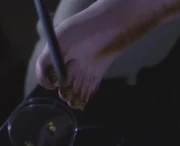
Denobulan foot and toe nails
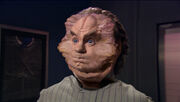
Phlox blows up his face
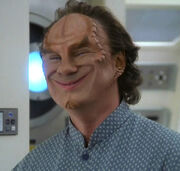
Phlox smiles an enlarged grin
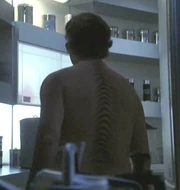
The back with ridges along the spine
Anatomically, Denobulans were considerably less simplistic than Humans. Denobulans had prominent facial ridges running down either side of the forehead to the cheeks, an enlarged brow ridge under a high receded hairline, a vertical crevice in the center of the forehead, and a ridged chin. (ENT: "Broken Bow", et al.)
Additionally, Denobulans had ridges on their back, along the spine. Their toenails were dark brown and yellow striped, and such nails grew so rapidly that they needed to be trimmed at least once a week. Denobulans also had very long tongues, and they used tongue scrapers. Denobulan males had a line of hair down the middle of their chest, up to their throat. (ENT: "Bounty", "A Night in Sickbay")
Denobulan females had very potent pheromones that the males could sense, and they released them when they were romantically interested in someone, and presumably during their mating season. Denobulan males were known to become violent during the mating season. (ENT: "Dear Doctor")
Denobulans had a unique ability to enlarge their faces. This was an instinct for when they felt threatened. (ENT: "Home") They could also display an unusually wide smile for humanoids. (ENT: "Broken Bow", "A Night in Sickbay", "Stigma", "These Are the Voyages...")
Denobulans seemed to change their eye color depending on their moods. (ENT: "Acquisition")
Denobulans normally required very little sleep, but they did hibernate for five to six days each year. However, at a minimum, two days were sufficient. Deep hibernation resulted in the sleeping Denobulan becoming unresponsive to noises, regardless of how loud they were, but they could be awakened via a particular drug delivered intravenously. If a Denobulan was awakened prematurely, the results could be somewhat unpredictable; hibernating Denobulans, if woken, appeared extremely disoriented and confused, with oddly pitched voices, and had difficulty maintaining normal motor skills and cognitive functions. (ENT: "Dear Doctor", "Two Days and Two Nights", "Similitude")
Denobulans had highly efficient natural climbing abilities similar to those of Earth lizards, being capable of scaling vertical rock faces at a rapid speed with no equipment whatsoever, appearing to scuttle up the rock face without needing to find handholds. (ENT: "The Breach")
Denobulans appeared to possess particularly powerful immune systems; when Phlox was nearly assimilated by the Borg, his immune system was able to fight off the nanoprobes long enough for him to find a means of destroying them, although he admitted that his immune system would not be able to hold them off indefinitely. (ENT: "Regeneration")
Denobulan lifespans were extremely long, though a Denobulan elder did not necessarily look particularly old. (ENT: "A Night in Sickbay") Phlox, in the 22nd century, once stated that his grandmother lived through Denobula's last war with the Antarans, a war which ended while Earth was in the 19th century. This indicates that at least three generations of Denobulans had existed during the three-hundred-year span between the events. (ENT: "The Breach")
Since the 20th century, the Denobulans practiced genetic engineering, with generally positive results. (ENT: "Borderland")
In common with such species as Humans, Vulcans, Ferengi and Gavarians, Denobulans could be drugged and rendered unconscious by anesthesia gas, such as when emitted from Ferengi gas canisters. (ENT: "Acquisition") Similarly, two Denobulan males who became overly aggressive with each other during the mating season could be separated using a dose of niaxilin. (ENT: "Dear Doctor") Another method of rendering Denobulans unconscious was a Vulcan mind meld. (ENT: "Singularity")
Some indications suggest that Denobulans were particularly susceptible to certain types of radiation. When exposure to an exotic form of radiation caused almost the entire crew of the NX-class Enterprise to exhibit irrational and obsessive behavior, Phlox was the only senior officer whose actions nearly led to the then-deliberate death of another of his crewmates, as he was adamant about using surgical methods to discover why Ensign Travis Mayweather was suffering from a headache. (ENT: "Singularity")
)
The Denobulan doctor Phlox once claimed that the Denobulans were severely afflicted by thymic sclerosis and that it was "found in all strata of Denobulan society." This, however, was a deceit. (ENT: "Stigma")
History
The Denobulans believed they were the only intelligent species in the galaxy until the B'Saari made first contact. (ENT: "Future Tense")
Denobulans fought several wars against the Antaran species. The last one was during the late 19th century. Denobulan battle tactics killed twenty million Antarans. The Denobulans demonized the Antarans and made them a faceless enemy (and vice versa). As of the 22nd century, there were still some Denobulans that hated Antarans, although most had outgrown the hatred. (ENT: "The Breach")
A few hundred years before the mid-22nd century, the Denobulans had a form of entertainment that was similar to movies. When they discovered their real lives were more interesting, the Denobulans abandoned this type of media, having found it had lost its appeal. (ENT: "Dear Doctor")
At one point, the Denobulans became embroiled in a medical emergency when there was an explosion aboard a cargo ship orbiting their homeworld. Various medical teams helped to deal with the aftermath, the detonation having claimed more than seventeen victims. (ENT: "Fight or Flight") This incident occurred either in 2115 or soon after that year. (ENT: "Fight or Flight", "Damage") By about the same time, the Denobulans had their own infantry. (ENT: "Damage", "Cease Fire")
The Denobulans first met the Human race sometime prior to the 2130s. This was around the time Nathan Samuels was eighteen, and when his father was killed in a crash involving a Denobulan pilot. (ENT: "Demons") By the 2130s, Denobulans and Humans had built the joint research station Cold Station 12. When the Vulcans formed the Interspecies Medical Exchange, Denobulans were involved and contributed medical personnel. (ENT: "Cold Station 12")
In 2155, a Denobulan ambassador was sent to Earth to join in talks of forming a Coalition of Planets. (ENT: "Demons")
There is evidence to suggest that Denobulans existed at least into the 23rd century; in 2155 of the mirror universe, T'Pol – having read from the library computer aboard the Federation starship USS Defiant, which originated in 2268 of the prime universe – told Phlox that Vulcans and Denobulans were equal to Humans in that universe. She expressed this to him in an effort to compel Phlox to help sabotage the Defiant. (ENT: "In a Mirror, Darkly, Part II")
Mirror universe
In the mirror universe, Denobulans were a slave race of the Terran Empire. The Denobulan Phlox served aboard the ISS Enterprise as the ship's doctor.
Denobulans were not part of the rebellion against the Empire, as it was not in their nature. Although Phlox helped the rebels sabotage the commandeered USS Defiant during Jonathan Archer's attempt to overthrow the Emperor, he did so in the hopes that the Emperor would reward him for his help with concubines. (ENT: "In a Mirror, Darkly, Part II")
People
Related topics
Appendices
Appearances
A list of all appearances of Denobulans (excluding Phlox's ENT appearances).
- ENT:
- "Stigma"
- "The Breach"
- "Cold Station 12"
- "Demons"
- "Terra Prime"
Additional references
- ENT:
Background
Identity
In the series run of Enterprise, the Denobulan species was originally not named. The script of Enterprise's pilot episode, "Broken Bow", omits any reference to the species' moniker, merely describing Phlox as "an exotic-looking alien." [5] Furthermore, Enterprise's creators did not, at first, devise a detailed perception of the species. According to Phlox actor John Billingsley, the reason why was that those production staffers were "swamped." (Star Trek Monthly issue 84, p. 42)
Upon auditioning for the role of Phlox, John Billingsley reckoned that the alien character's species was "some kind of birdlike creature." This impression provided a basis for the actor's initial performances as Phlox; they involved him occasionally squawking. [6]
Although a subsequent discussion which John Billingsley had with Executive Producers and show creators Rick Berman and Brannon Braga concerned Phlox's philosophical attitude in general, it did not relate to his genus. "We didn't really talk at all about the background of my species or why we haven't encountered this species before," offered Billingsley. (Star Trek Monthly issue 86, p. 27)
Following this conversation with the series creators, John Billingsley proceeded to formulate a personal interpretation of what Phlox's kind may be like. Shortly afterwards, he explained, "My own sense is that it's a race of people who are hyperintellectual philosophers who have, in effect, chosen a monastic existence, and have decided to kind of hide away from the rest of the universe because they've got bigger fish to fry inside themselves!" (Star Trek: The Magazine Volume 2, Issue 7, p. 28) The actor further commented, "I see Phlox as from a planet where everyone is a teacher and philosopher. Everybody is navel-gazing. But one of the problems with navel-gazing is that it can make one insular and withdrawn from outside events." (Star Trek: Communicator issue 135, p. 33) Billingsley also supposed, "I don't think my species tends to make what I would consider the artificial distinctions that we tend to make between disciplines [such as anthropology, philosophy and medical sciences]." (Star Trek Monthly issue 84, p. 42)
John Billingsley thought the highly detached aspect of his imagined version of the species might canonically explain why the Denobulans had never been depicted on Star Trek before the advent of Enterprise. He fully expected that the species would be explored by the series creators in such a way as to contradict his own concept of the group, an eventuality he was prepared for. With a laugh, however, he also said of his idea, "Maybe if I say this enough times, they'll subscribe to it themselves." (Star Trek Monthly issue 84, pp. 42 & 43) Moreover, Billingsley posited that his notion of the species might work well in sync with how the producers conceived of it, remarking, "[Brannon Braga]'s feeling is that the Denobulans are very advanced and very happy and very positive. One can speculate from that that they simply don't really have a tremendous need to be involved in the affairs of the universe. I mean, maybe it's so Eden-like [on Denobula] that it's like, 'Oh, what do I want to go out there for? I've got everything that I want right here.'" (Star Trek Monthly issue 95, p. 43)
The name of the Denobulans was first canonically established in ENT: "Terra Nova", the fifth episode of Enterprise, but a Denobulan appears in the first four episodes of the series. The only installment of those four to make reference to the group is the second one, "Fight or Flight", in which Phlox talks about "people" on his homeworld (the reference in "Terra Nova" is much more direct, with him literally stating, "I am a Denobulan," upon introducing himself to Novans).
During the course of the series, the writing staff of Star Trek: Enterprise exercised extreme caution in regards to establishing facts about the Denobulans. John Billingsley approved of this course of action, believing that the mysterious quality of the species helped make Phlox intriguing. (Star Trek Monthly issue 100, p. 7) He conjectured, too, that the producers were of a similar opinion. "I suspect that they feel tidbits every now and again might keep peoples' curiosity up," Billingsley hypothesized, "as opposed to doing an entire episode about Denobulan society that perhaps by revealing too much information may actually squelch peoples' interest." In the first season, Billingsley nonetheless pitched a couple of story ideas to the writing staff about the Denobulans on their homeworld, though these were not accepted. (Star Trek: Communicator issue 152, p. 24)
While appearing on Comedy Central's The Daily Show on Monday 11 September 2002, Scott Bakula described Denobulans as "some kind of bird/reptile." Also, host Jon Stewart jokingly suggested that the typically polygamous nature of Denobulans made them similar to Mormons. [7]
Even though the name "Denobulan" was used fairly often in the series, the script of "Stigma" includes the word in its pronunciation guide. [8] Before the first Denobulan woman was portrayed in that episode (Feezal, who was also the first Denobulan to ever appear on-screen, with the exception of Phlox), John Billingsley repeatedly joked that he would like his wife in reality, Bonita Friedericy, to play all Denobulan women that appeared on the series. Billingsley thought that would be "fun", would allow his wife to feature into many episodes, and would supply the couple with more residual checks. [9] Billingsley also wanted any Denobulan males that showed up on the series to be played by himself. "That way, everybody on Denobula was either John Billingsley or Bonita Friedericy," he later related. Denobulan at StarTrek.com
John Billingsley's thoughts on the Denobulans included speculations about their sexuality. In an interview with Dreamwatch magazine, the actor referred to the Denobulans as "known bisexuals," although that differs from how they were represented in canon. [10] Also, Billingsley once humorously speculated to the series' writing staff that, due to Phlox having three wives, he would likely have "three members." Even though this idea concerning Denobulan sexual organs was not adopted by the writers, the conversation in which Billingsley suggested it led to more of the Denobulan physique being shown on-screen, in "Doctor's Orders", than had ever been depicted before. (Star Trek Magazine issue 115, p. 36)
The backstory involving the Denobulans' war with the Antarans, as established in "The Breach", did not meet the approval of John Billingsley. He critiqued, "I think coming up with an episode where Denobulans were once war criminals, there was still this credible anger that had not been resolved, it seemed to me at least – and maybe some of the fans too – a little too jarring, a little too difficult to jive with what we knew about Phlox." Billingsley added that, although there were some elements of the script for "The Breach" that he found fault with, the Denobulans' warring had somewhat been alluded to in previous installments, such as a reference to the Denobulan Infantry in "Cease Fire". [11] In fact, even the existence of a Denobulan military came as a surprise to Billingsley. (Star Trek: Communicator issue 152, p. 22)
By the end of the second season, there was some fan speculation that the Denobulans were later to be revealed as the Cardassians going under a different name, despite the lack of on-screen evidence to support this theory. (Beyond the Final Frontier, p. 380) The question of whether the two species were related was, according to John Billingsley, never discussed. Denobulan at StarTrek.com
The only performer to make appearances as multiple Denobulans was regular background actress Nikki Flux, who played members of the species (in an uncredited capacity) in "Cold Station 12" as well as the two-parter "Demons" and "Terra Prime". Two different Denobulan characters were portrayed by her in these episodes but neither of them were named.
In contrast to his satisfaction with the way in which the writing staff released scraps of information about the Denobulans every so often, John Billingsley conceded that, had he been given the chance to contribute story material for the series, it would have comprised of revealing more about the Denobulans. He expressed, speaking in a retrospective interview, that he would have liked to learn more about the Denobulans' culture and their belief systems. [12] Left to ponder the mystery of what finally happened to the Denobulans, Billingsley mused, "There are no Denobulans in the future, apparently. I think we were an inbred species and I guess we eventually went the way of most inbred societies." Denobulan at StarTrek.com
If Star Trek: Enterprise had gone onto a fifth season (rather than being canceled after its fourth one), the Denobulans would likely have been shown in greater depth than they ultimately were because, shortly before the cancellation was announced, Manny Coto voiced an interest in visiting Denobula in the fifth season. [13]
Makeup
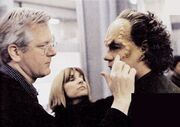
The Denobulan facial makeup for Phlox is tweaked
When starting to imagine what a Denobulan's face might look like, Makeup Supervisor Michael Westmore was guided by advice that each of the actors playing the aliens was to have only a subtle makeup job. "The producers wanted him [or her] to look a little more human than some of the characters from the past, like Odo or Neelix," Westmore recollected. Working out the details of this facial design took considerable effort, however. "We really didn't know what we wanted [...] so I hired five other artists, all sketching away for two weeks, and I ended up filling a notebook with more than 80 sketches," stated Westmore. "I'd literally come home and [Westmore's wife] Marion would say, 'Go in the other room and draw!' and the other guys would be faxing me their sketches over the weekend and I'd call them back and say, 'That's the direction we want to go; keep going that way.' It seems that everyone wanted to get more flamboyant and larger than life, and I knew that wasn't what Rick and Brannon wanted, but would feed me into ideas that I could show them and know what they really wanted." (Star Trek Monthly issue 98, p. 43)
Eventually, makeup and other appliances were used to accentuate the actor's forehead, chin, ears and own hair with extensions and alien shaping. (Star Trek: Communicator issue 135, p. 34) "I decided to enhance the edges of his [or her] skin with a little Dax-like pattern," Michael Westmore explained. The actor also wore contact lenses that increased the brightness of his or her eyes, though their natural basic skin tone was retained for their Denobulan appearance. (Star Trek: Communicator issue 135, p. 67) Whereas the actor's own hair was also included in their Denobulan look, the performer wore three separate prosthetic pieces, along with the contact lenses. These parts consisted of an artificial forehead, chin and ears, all of which were painted over in a variety of shades. (Star Trek Monthly issue 86, p. 28) According to Westmore, the fact that the makeup worn on the actor's face was mostly restrained to above their eyes was due to the producers' decision to have the makeup be relatively minimal. Similarly, Westmore reflected that he added the small chin piece "for balance" and that the contact lenses were intended "to give us something different." (Star Trek Monthly issue 98, p. 43)
The process of applying the makeup required for the Denobulans' alien demeanor originally took three hours but had been shortened to two hours by the time the species received its name. (Star Trek: Communicator issue 135, p. 34) "The prosthetics they can do in 15 or so minutes," clarified John Billingsley, "but it's the actual painting and modelling that takes a while." (Star Trek Monthly issue 86, p. 28)
John Billingsley was impressed by his first sight of the Denobulan makeup, as sported by himself. "I thought it looked terrific. I thought I looked kinda sexy in a way!" the actor reminisced with a chuckle. "I'm not sure anyone else will echo those feelings." (Star Trek Monthly issue 86, p. 28)
Even from the outset, the Denobulan makeup was extremely comfortable to wear. (Star Trek Monthly issue 84, p. 23) John Billingsley noted, "It hasn't been a problem at all." He also considered himself "lucky" that, unlike certain other Star Trek performers, he did not have to wear a huge amount of rubber, nor dentures which might have brought him pain. (Star Trek Monthly issue 86, p. 28)
To demonstrate Denobulan feet in "A Night in Sickbay", new foot prosthetics were donned by John Billingsley. [14] For the female variant of the Denobulan facial makeup, Michael Westmore slightly streamlined the male version in order to make it a little bit more attractive-looking. {"Stigma" text commentary, ENT Season 1 DVD)
Apocrypha
The Pocket ENT novel What Price Honor? includes Phlox referring to the Denobulans as "relative newcomers to space [...] – at least compared to the Vulcans."
In accordance with the script for "Singularity", the novel Surak's Soul establishes that Denobulans are more susceptible to radiation sickness than Humans. The same book also indicates that Denobulans have their own standard form of radiation treatment, despite also having a very similar skeletal structure to members of the Human species.
In the novelization of The Expanse, T'Pol is said to have studied Denobulans but never met any other member of the species, apart from Phlox, by the time of the story's setting in 2153.
The novel Daedalus's Children establishes that a male Denobulan named Parnikee was an esteemed and highly accomplished scientist. He invented the matter/antimatter engine on the planet, led the first Denobulan exploratory vessel and predicted the existence of parallel universes. Parnikee also provided at least the namesake for Parnikee's Theorem – a Denobulan theory that set forth the rate of the universe's expansion, an equivalent of the Hubble Constant – though it is unclear whether he was personally involved in devising that theory.
The novel Rosetta includes Phlox relating, to several of his crewmates aboard Enterprise, an unfortunate story that concerned a delayed shipment of antibiotics to a Denobulan colony, with the Thelasian Trading Confederacy at fault.
The TOS novel The Case of the Colonist's Corpse refers to Denobulan caviar.
Several Star Trek novels set in the 24th century have Denobulans in them. Some references include the Star Trek: The Lost Era novel The Sundered, which has a Denobulan engineer on the USS Excelsior. A dead Denobulan is featured in the second novel of the Star Trek: Vanguard series, Summon the Thunder. One of the USS Enterprise-E's doctors, Tropp, is a Denobulan in the A Time to... series.
In the game Star Trek: Elite Force II, several Denobulans are among the crew of the USS Enterprise-E.
External link
- Template:NCwiki
